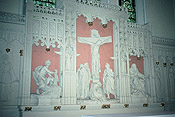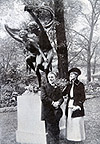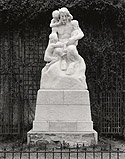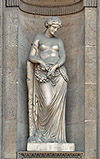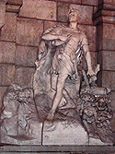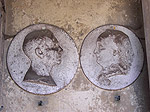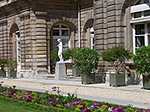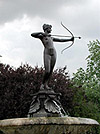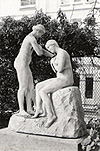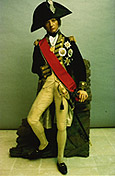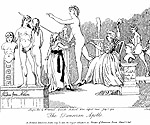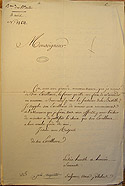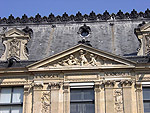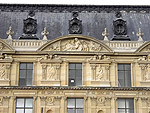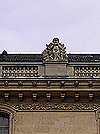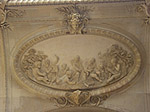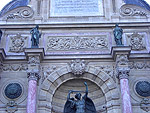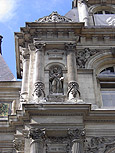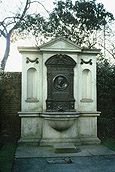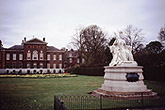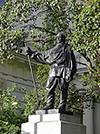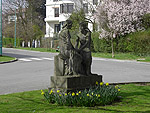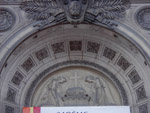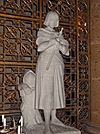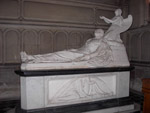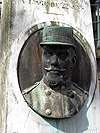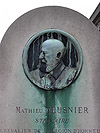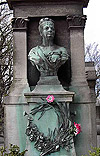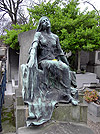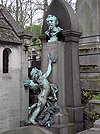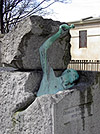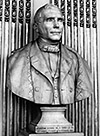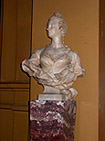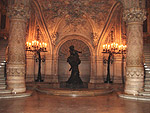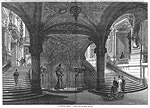The browser will either open the file, download it, or display a dialog.
|
|
The Invisible “Sculpteuse”: Sculptures by Women in the Nineteenth-century Urban Public Space—London, Paris, Brussels1 |
||||||
|
Introduction |
|||||||
|
Beginning in the late eighteenth century, the production by “sculpteuses”4 for the public realm increased substantially and the number of extant nineteenth-century public sculptures by women is surprisingly large, even though for the most part their visibility in public spaces is, and usually was, low, due to choices of media, format, genre, and especially placement. Literally and figuratively, women sculptors were allowed to operate largely at the margins of the public space, making works with less weighty subjects, in less important formats and genres and for less prestigious venues, frequently for what may be called semi-public spaces—border zones that themselves were in-between the public and the private. |
|||||||
|
In focusing on the placement as well as the subjects and media of women’s sculptures in the public space, I intend to explore this border zone where women sculptors were allowed to operate and from where, on occasion they could break out into the center of the public arena. This article, which occupies a specific niche in the relatively new research domain of women sculptors,5 is not concerned with biography, nor will it tackle the question of women artists’ training opportunities or the institutional and societal impediments they met, however crucial these were for the actual living and working conditions of the women at issue.6 My focus in this article, instead, is on the commissioning and placement of women’s public sculptures (of a permanent, not temporary nature).7 |
|||||||
|
As this article presents a case study and not an overview of public sculptures by women worldwide, I have restricted its scope to three Western-European capitals: two major (art) metropolises that were especially important for sculpture in the nineteenth century, Paris and London, and one small city in between them, Brussels, added to the mix to achieve a more complete and representative analysis.8 The notion of public space is used in the broadest sense as any space accessible by the general public. This means that my study is not confined to exterior spaces that were or are legally defined as “public,” but extends to outdoor and indoor “semi-public spaces,” such as cemeteries, churches, schools, and governmental and cultural buildings (excluding museums), because these seem to form the biotope of women’s urban sculptures. I will use the term “public” to refer to all these spaces. |
|||||||
|
This article begins with a general analysis of the specific locations of nineteenth-century public sculptures by women in Paris, London and Brussels. The second part explores some female pioneers in public sculpture and the reasons why their work could be, or is often, seen as “marginal.” The third section looks at the different urbanization campaigns of the three cities and the (im)possibilities these offered for women sculptors. The fourth and final section zooms in on the possible relation between gender and the iconographical, material, and stylistic features of the sculptures under discussion, as well as their precise topography within the city. |
|||||||
| Agoraphobia or Agoraphilia? During the period from 1789 to 1914, at least 230 sculptures were commissioned from women artists for public spaces in Paris, London and Brussels.9 Since women’s public sculptures are nearly absent in current art historical writing, this number is unexpectedly high. Indeed, one might speak of it as a revelation, though it is one that is the result not of divine intervention but of intensive research in libraries, archives and the public space itself. Not all of these 230 sculptures are still found in situ, as several were lost, broken, melted down, or stolen. The number also includes a few important commissions that were eventually cancelled. |
|||||||
|
Though the number of 230 seems high, it is extremely low in relation to the number of public sculptures that were produced by men. The female contribution to the public sculptural repertory in the three cities lies somewhere between zero and three percent.10 That is not so surprising; not only were sculptresses obviously a tiny minority (between zero and ten percent of the sculptors represented at the Paris and Brussels Salons and the Royal Academy exhibitions of the long nineteenth century, depending on period and city), but they had less reason to hope for public commissions than their male colleagues. Over eighty women sculptors were responsible for the 230 sculptures, which means that, on average, each received fewer than three public commissions in a lifetime, at least for the cities under consideration, as the same sculptresses often received commissions in other places too, often in their hometowns. |
|||||||
|
More than three quarters of the 230 sculptures are found in Paris. The discrepancy between the numbers in Paris and London is surprising, the more so as in the late eighteenth century the number of public sculptures made by women had been approximately the same in both cities. London does come in second, however, while Brussels, the smallest of the three cities, comes in a distant third. Not only does it have the fewest sculptural objects by women in the public space, but the sculptures also come last chronologically, as they begin to appear only around 1900. While the conditions and contexts in which the sculptures by women in the three cities were commissioned and installed differ greatly according to time and space, it is clear that in all cases urbanization, population, political and economic situation, state patronage, women’s emancipation, and artistic taste played an important role. |
|||||||
|
Many of the sculptures by women were and still are found in the hearts of the cities for which they were made, which is logical in view of historical urban development. In Paris, this roughly means the first seven arrondissements, in particular the first and fifth, and additionally the ninth and tenth. In London, this means Inner London, to the north of the Thames, particularly the City and the West End, at that time already tourist and “woman friendly” areas,11 as well as the affluent area of Kensington. |
|||||||
|
In both Paris and London, women’s sculptures can also be found in governmental districts, in or near government buildings and locations of power, such as city halls, ministerial departments, courts of law, or embassies—though they are rarely the most visible sculptures in those areas. A typical example is the bust of Napoleon III by Azalaïs Marie-Louise Lefèvre-Deumier, (born Roulleaux-Dugage; 1812–77), of which the French state ordered one copy in marble and fifty in bronzed zinc in 1852, the year of his coronation. Several of these busts ended up inside Parisian government buildings in the 1850s and 1860s, including the Ministries of Public Works and of Finance, and the Cercle des Préfets.12 In London, women artists’ sculptures can be found, among other places, in and near the Bank of England, in the gardens of the Inner Temple, and in the Central Criminal Court, commonly known as the Old Bailey, which houses the marble statues of James I (1864) and Charles I (1864) by Thomas Thornycroft and his wife Mary, (born Francis; 1809–95), which were originally intended for niches, which proved to be too small, in the Houses of Parliament.13 |
|||||||
|
Women’s sculptures exist not only in the densely populated city cores, but also in the urban extension zones, especially in Paris and Brussels. Sculptures found in these zones most often date from after 1900 and are often decorative rather than political; they were probably meant, in the first instance, to “brighten up” the areas where they were installed. An example is the nude marble Aurora, which the French state ordered in 1904 from Marie-Louise-Henriette-Marguerite Gegout-Gagneur (1857–1945),14 known under the pseudonym Marguerite Syamour, for the Allée des Orangers in the park of Saint-Cloud but which was placed five years later in the garden of the Ministry of Justice at the Place Vendôme. Various agencies commissioned these public sculptures. In 1905, the marble Fortuna, (fig. 1), by Laure Coutan-Montorgueil, (born Martin; 1855–1915) was placed in the park of the Choisy-le-Roi town hall, thanks to a commission by the Département de la Seine. Two years later, it was the French state, which ordered from Blanche Moria (1859–1927) the marble group The Botanics Class, to be placed in the playground of the Lycée Molière in the sixteenth arrondissement. Not all sculptures in the urban extension zones were “decorative.” Some had a specific, local connection, such as Voltaire’s bust, by Marguerite Syamour, in his alleged place of birth Châtenay-Malabry.15 |
|||||||
|
In view of the (sub)urbanization of London, one might expect the works of sculptresses to be plentiful in the affluent suburbs and leafy districts on the edges of the city. However, with what appears to be just two exceptions—a multiple altarpiece by Emmeline Halse (1853/56–1930) in Saint John’s Church in Notting Hill (fig. 2), and a funeral monument at Hendon cemetery, presumably designed by the French-Italian Félicie de Fauveau (1799–1886), such works are missing from both the landscape and any reference work. |
|||||||
|
Though present in the city center, sculptures by women often seem to be confined to its margins. So while nineteenth-century sculptresses themselves often stood out in the profession as “rare birds,” their sculptures were and are much less distinctive in the cityscape, as they are rarely prominently visible in the open air. The “top locations” for monuments—central squares and parks—were rarely allowed to sculptresses. Only about ten percent of the sculptures by women in the three cities from the period 1789–1914, that I traced for this research, stand or stood in a square or in a park. Most of these date from the late nineteenth and early twentieth centuries and are located on the outskirts of the city. The first freestanding sculpture by a woman that was commissioned (in 1910-11) for one of the main parks of Paris, the Jardin du Luxembourg, was not installed until 1919. It was Russian Dancers by the American Malvina Hoffman (1885–1966), which the occupying German forces melted down in 1942 (fig. 3).16 Also in 1911, the city of Paris bought Yvonne Serruys’s (1873–1953) monumental marble Faun with Children and placed it (in 1930) on the Place Louis Blanc. While that may sound prestigious, the Place Louis Blanc is a forgotten little square near the Gare de l’Est, where Serruys’s sculpture is placed on a pedestal but with its back to a wall (fig. 4). |
|||||||
|
Could it possibly be argued that nineteenth-century female sculptors suffered from “agoraphobia” (a pathology named in 1871 and, since around 1900, diagnosed considerably more frequently in women), in the figurative, not the psychopathological-diagnostic sense? Was there a kind of unconscious reluctance among nineteenth-century sculptresses to take up public space, as if stepping into the limelight was a difficult move for women to make? This is of course a difficult matter to answer, but my research suggests that rather the contrary was true: at least several of the retraced sculptresses actually tended to “agoraphilia.” They sought the public space, in their competing for public sculpture and in their sometimes explicit appeals to the responsible authorities for “good” public places for their sculptures. Letters to commissioning authorities testify to the fact that several sculptresses, just like their male colleagues, aspired to central squares and parks as locations for their works.17 They strove for the best spots, but were usually kept from them. Probably deeply rooted convictions at the urban planning decision levels, invariably dominated by men, about the role and place of women in society played a role in this. Indeed, if there was a phobia that stood in the way of women artists’ occupation of public spaces, it rather was gynophobia—a term used not in a psychopathological but in a figurative sense. |
|||||||
|
Only during the latter decades of the twentieth century did permanent sculptures by women (Germaine Richier (1904–59), Louise Bourgeois (b. 1911), Magdalena Abakanowicz (b. 1930) and Anne Rochette (b. 1957)) get a place in the prestigious Jardin des Tuileries. At the beginning of the century, Thérèse Quinquaud-Caillaux’s 1903 request to place her group Le Passé et l’avenir in the park was refused, as was her offer, seventeen years earlier, to donate Le Porte-drapeau du bataillon scolaire to the city of Paris, provided the city would have the statue cast in bronze and placed in a public space.18 |
|||||||
|
Most nineteenth-century outdoor sculptures made by women were not freestanding, but somehow related to architecture, as if the building provided them with “support” and “protection.” Bas-reliefs and high-reliefs, placed in or against exterior or interior walls, account for about a quarter of the total number of public sculptures by women. On the whole, reliefs were cheaper and easier to execute than sculptures in the round. In sculptural criticism, they were and are accorded a lower status; indeed, most overviews of nineteenth-century sculpture and most summary guides of public sculpture in the three studied cities pay little or no attention to either relief sculpture or any form of façade sculpture. |
|||||||
|
Even when they were sculpted in the round, many sculptures by women were attached to, or placed against walls, at times in “sheltering” niches. Marie-Louise Lefèvre-Deumier’s stone semi-nude nymph Glycera (1856-61) for example, is found in a ground-floor niche of the Louvre’s Cour Carrée (fig. 5).19 Sometimes women’s sculptures are positioned right next to buildings, figuratively and often literally in their shade. In other instances, they are placed so high up on buildings or monuments that they can only be seen from afar, or unclearly, or both. In this category are all sculptures made by women, other than Glycera, for the outside decoration of the Louvre. |
|||||||
|
Over half of the retraced public sculptures by women were given a place inside a building. Though these sites include important government buildings, esteemed cultural institutions, and impressive cathedrals and churches, interior sculptures, by and large, and with the exception of museum collections, are less prestigious and visible, and they are featured less often in reference works on nineteenth-century sculpture than are monumental open-air sculpture. In addition, interior sculptures done by women are often less prominently displayed than those by men. The monumental walking Saint Hubert with Hounds (1889) by Anne de Rochechouart-Mortemart, Duchess of Uzès, (1847–1933), in the famous Sacré-Coeur basilica in Paris, for example, is almost invisible, positioned as it is in the furthest, darkest corridor of the basilica crypt (fig. 6). Similarly, the bust (1864) of the composer Jacques Fromental Halévy by his wife Léonie (1820–84) is inside the Halévy family vault in the Montmartre cemetery, accessible only to an intimate circle, and the portrait medallions (1867) of Eugène Scribe and his wife by Marguerite-Fanny Dubois-d’Avesnes (1832–1900), are inside their monument in Père-Lachaise, while on both monuments there is also sculpture on the outside, by male sculptors (fig. 7). |
|||||||
|
The fact that women seldom saw their sculptures in “top locations” can be linked to the genres they mostly practiced (portraits, mythological figures) and the formats in which they worked (reliefs and life-size or smaller-scale sculptures). But was this a cause or an effect of their limited access to the public space? The question is difficult to answer but it remains true that sculptresses were rarely given commissions for the highest genre in the hierarchy of public sculpture: the huge historical equestrian monument in a public square. In the three cities in this study, no woman ever realized an equestrian statue, although there are examples of equestrian monuments by women, dating from the late nineteenth and early twentieth century in New York, Washington, DC, Copenhagen, Seville and Blois. Women made some full-length statues, but they are seldom placed on a high pedestal with plenty of space around them. Consequently, public sculptures by women usually do not seem to have been designed for the monumentality of public space; they are often, essentially, interior sculptures that may or may not have been placed outside. |
|||||||
|
Over half of all public sculptures by women from the period 1789–1914 are portraits, rarely larger than life-size. Although portrait sculpture was often privately commissioned, portraits of famous persons could attain a public function, and be commissioned from public institutions. Surprisingly many sculptresses had access to famous men (and women) through their family and social networks, and thus obtained public portraiture commissions. Obviously, men also made many portraits, but this (lower) genre was deemed especially appropriate for women, in sculpture as well as in painting. Portraiture did not require that women study the nude human body, a controversial issue at the time, and the sitter could come to the sculptress’s home. Most of the busts by women sculptors (many of them of actors, musicians, and artists, but also official portraits of statesmen) ended up in public interiors or in cemeteries, where an intimate, semi-private sphere was preserved. |
|||||||
|
About one third of women’s sculptures were primarily meant to decorate the public space. Such decorations often would take the form of putti, children, or mythological or allegorical figures, usually female—dressed or nude. The relation between sculptresses and the female nude was of necessity problematic as contemporary viewers were often looking at once for the seductiveness expected of a nude and the chastity expected of a woman artist. This problem was even greater for sculptors than for painters, due to the three-dimensionality of their medium and the fact that it required direct physical contact with the material. The mere thought of a woman shaping a nude in clay with her fingers, as if touching another female body, was shocking to some. Moreover, women’s hands were not supposed to be rough and soiled with clay but soft and clean to caress and care for her husband and children. So, for their nudes to be acceptable, sculptresses had to seek a delicate balance between showing and hiding, between active and passive, and between public and private. |
|||||||
|
Interesting in this respect is the nearly seven-foot high, full-length Faithful Shepherdess (1863), which the Corporation of the City of London ordered from Susan Durant (ca. 1825–73) in 1861 for the Egyptian Hall in Mansion House as part of a series of statues glorifying English literature (fig. 8). While the subject has one breast revealed, which might be seen as mildly seductive, her gestures refer explicitly to the fidelity of the chaste shepherdess Clorinde in John Fletcher’s pastoral play The Faithful Shepherdess. Like Susan Durant, Hélène Pilate-Hébert, better known as Mme Léon Bertaux (1825–1909), also successfully balanced seductiveness and chastity in her marble statue Psychè sous l’empire des mystères (1889). Though entirely nude, the figure’s closed form, small breasts, and introspective expression lend it an air of youth and innocence and the sculpture, in effect, was praised for its chastity.20 It received a gold medal at the Paris Salon in 1889, was bought by the French State, and eventually ended up in the Luxembourg Gardens, in front of a sidewall of the Senate (fig. 9).21 Feodora Gleichen’s (1861–1922) Diana (1899), high up on a fountain, which was donated by a female private owner for London’s Hyde Park in 1906, is another such example (fig. 10). Gleichen modeled Diana nude, poised to fire a lethal shot—a remarkably active and assertive pose when compared with the more usual, passive portrayal of the virgin huntress, bathing or with bow and arrow hanging loosely in her hand. Gleichen opted for a lithe and athletic figure, presumably to stress Diana’s embodiment of chaste femininity and to reduce the erotic possibilities of her figure, in a period that saw the rise of the “new woman” practicing sports. Similarly, Yvonne Serruys’s state-commissioned monumental nude marble Bathers (1910–13) in the front garden of the Ecole Normale Supérieure (5th arrondissement), shows a chaste and realist femininity (fig. 11). The women appear real—subject to the force of gravity and with defined musculature—and in their intimacy hide rather than show their bodies. |
|||||||
|
Not only in their sculptures but also in their own lives, sculptresses had to navigate carefully between the public and the private spheres: between the expectations of the art world on the one hand, and those of society and of their own families on the other, that is, if they had a family. Remarkably, a considerable number chose a life without a male partner, without children, or without either.22 |
|||||||
|
The participation of the most talented and ambitious sculptresses in public sculpture was accepted, but only within certain limits. They received commissions and sold their sculptures, but the orders were seldom for large, impressive works, and the placements were seldom in important sites. Anne Digby’s concept of “borderland,”—a social “gray area,” between the public and private spheres, in which Victorian women enjoyed a certain public freedom,23—provides a relevant framework for viewing the sculptresses and their works. They were operating in a “marginal area,” where they were tacitly allowed just a little more than what Victorian values stipulated. This “area” did have a “glass ceiling,” though: sculptresses were tolerated up to a point in the public space, as long as they did not become too visible or too “loud,” and as long as their conduct and works were within certain bounds. |
|||||||
| The Female Pioneers in Public Sculpture The earliest three-dimensional public artworks made by women in Paris, London, or Brussels—wax figures, decorative architectural sculptures, bas-reliefs, and portrait sculptures—all suggest the sculptural “back alleys” through which eighteenth-century women artists entered the domain of public sculpture. The first of these, made by women in London and Paris, were probably wax figures. These were life-size clothed effigies for which women modeled the hands and heads, hyper-realistically, in wax (the clothes were, probably, usually made by women too, but there is hardly any research on this yet). Women had built a specialist tradition in wax modeling, going back at least as far as the Middle Ages, when nuns made candles, flowers, and statues of saints in wax. Such work, which continued through the seventeenth and eighteenth centuries, has always remained outside the art-historical canon, but it is probably precisely through this kind of “outsider” activity that women entered the field of public sculpture.24 During the eighteenth century, especially, a number of enterprising women, such as Mary Salmon (1650–1740), Martha Gazley (act. c. 1730–50) or Marie Grosholtz (1761–1850), later known as Mme Tussaud, specialized in waxworks of prominent contemporaries, and some even traveled from city to city in order to show their home-made, but very popular collections of waxworks of prominent contemporaries to the local public for a fee.25 |
|||||||
|
Some women were also commissioned to make waxworks for the more prestigious and enduring funeral collection of Westminster Abbey. Among them are the wax images of William Pitt the Elder, Earl of Chatham (1775–79) by the American Patience Wright (1725–86), and of Lord Nelson (1800-06) by Catherine Andras (1775–1860, fig. 12). The latter work was an extremely life-like effigy of the immensely popular naval hero, modeled from life and said to wear some of his original pieces of clothing. It drew a record number of visitors to Westminster Abbey, which was exactly the point of its commission, as the Abbey wanted its share of the flood of visitors to St Paul’s Cathedral, where Horatio Nelson was buried.26 These effigies are among the earliest permanent public three-dimensional works by women in the metropolis. So women artists early on succeeded in obtaining important commissions for enduring wax effigies and in so doing reached a wide and diverse public. But wax sculptures have the disadvantage of being fragile; they do not tolerate heat or too much light, so, after initial prominent displays, they were and are usually preserved in display cases placed in dark corners or cellars. Although most of them are extant, they have lost the public’s attention and, seen as “Low Art” rather than “High Art,” they are missing almost completely from art history. |
||||||
|
While enterprising women like Mme Tussaud influenced late eighteenth- and nineteenth-century culture through their wax figure shows, another female entrepreneur, Eleanor Coade (1733–1821) left her mark on the cityscape of Georgian London. Beginning in 1796, she further developed and successfully commercialized an existing procedure to manufacture a hard-wearing artificial stone, and called her product “Lithodipyra,” and, later, the easier to pronounce and remember “Coade stone.” Because there were no quarries in London’s vicinity, many architects and contractors used the material for sculptural decorations, which often carry the imprint “Coade.” More than one thousand designs were produced in Coade’s Lambeth factory. Coade, herself, designed some of these; the others were designed by (mostly male) sculptors that she employed.27 |
|||||||
|
But British female sculptors were not involved exclusively in “low” sculptural forms like waxworks and architectural decorations. In the summer of 1798, the London sculptress Anne Seymour Damer, (born Conway; 1748–1828), thanks to her connections with Sir William and Lady Emma Hamilton, was able to persuade Horatio Nelson to sit for her when both she and Nelson were in Naples. In January 1799, Damer offered a plaster cast of her neoclassical bust of Nelson in modern dress to the City of London Court of Common Council. The marble version, which followed later—it was only finished in 1803 and publicly exhibited the year after—was initially put in the Common Council Room, then in the dining room of the Guildhall when Nelson’s death was announced, and finally in the present Guildhall Art Gallery.28 Damer knew that donating portraits, especially celebrity-portraits, could be a clever strategy to further her career, and she employed that strategy frequently. |
|||||||
|
Immediately after Nelson’s death in 1805, Damer attempted to secure a commission for a public monument in his honor for the Guildhall. The London Common Council read a letter during its meeting of November 26, 1805 in which Damer nominated herself for the execution of a monument for Nelson:
In response to her request, the Council members ensured Damer that “they have felt flattered by your very generous and patriotic offer,” but, in the same letter, they informed her that it was decided to hold an anonymous contest.30 Damer participated, but James Smith won.31 |
|||||||
|
Nevertheless, Anne Damer may have been the author of the earliest freestanding outdoor sculpture by a woman in London, or even, perhaps, in Europe. The work in question is the metal-reinforced wooden statue of an Apollo with a lyre (c. 1794) atop the former Drury Lane Theatre. Both the theatre and the statue went up in flames in 1809 but they are depicted in contemporary engravings (fig. 13).32 The attribution of the Apollo to Damer has been put forward by Rupert Gunnis, an attribution supported by a few contemporary cartoons that link Anne Damer, an Apollo statue, and the Drury Lane Theatre.33 One example is a cartoon entitled The Damerian Apollo, published in 1789 by William Holland in London (fig. 14). It shows a sculptress, (the title suggests Anne Damer), in fully “feminine” dress, chipping away at a monumental male nude resembling the Apollo Belvedere.34 |
|||||||
|
If the cartoon in question, indeed, refers to plans (be they realized or not) for Anne Damer to make an Apollo statue for Drury Lane Theatre, it suggests that the idea of a female sculptor making a monumental male nude, to be shown in the public space, was seen as threatening at the time, as Damer is depicted as a destructive force, a threat to Art.35 The force with which her hammer is about to strike the chisel is incompatible with the fine detail of the finished sculpture, and threatens not only to wreck it, but even to castrate it (when the position of the chisel—exactly at the imaginary meeting point of the print’s two diagonals—is noted). Moreover, the other sculpted bodies in the cartoon either lack genitalia, or are protecting them.36 As feminists, who would later plead for women’s right to vote, were sometimes compared to a “castrating mob” and as Damer was an early bluestocking,37 it is not implausible that the cartoon intends to depict a castration scene. It could then be read as a humorous defensive reaction against the new phenomenon of a few bold women, Damer up front, who thought they could infiltrate the "male" domain of sculpture, and the "male" public space at that. At a moment when female artists—and sculptors in particular—their public visibility, and the female gaze (especially at the male nude)38 were anything but obvious, this was undoubtedly considered an all too visible threat to the “natural order” and delineation of space. |
|||||||
| Participation in Urbanization Even though there is no flawless correlation, there is an obvious link between the nineteenth-century urbanization history of Paris, London, and Brussels and the placement of public sculptures by women in those cities. Like their male counterparts, nineteenth-century women artists saw and seized the opportunities offered to sculptors by urban expansions. They strove for important commissions for sculptures in prestigious places, and succeeded in getting some, but they often received the somewhat less important ones. |
|||||||
|
In the late eighteenth and early nineteenth centuries, Antoinette Desfonts-Gensoul (act. c. 1790–1800), Julie Charpentier (1770–1845), and Félicie de Fauveau, participated in state commissions for the sculptural decoration of Paris. Julie Charpentier, a student of Augustin Pajou’s, received, from the director of Public Works, commissions for two allegorical bas-reliefs—Surgery (1816) and Geography (1821)—for the marble basin under the gigantic plaster elephant—not yet cast in bronze—ordered by Napoleon Bonaparte. By mentioning her desperate financial situation as a single woman of poor descent, who took a badly paid extra job as a taxidermist at the Musée d’Histoire Naturelle, the Minister of the Interior, who had recommended Charpentier for the second commission, may have hoped to save her from a life of poverty through a state commission, for which she thanked him humbly but competently (fig. 15)39:
Charpentier exhibited the plaster model Surgery at the Paris Salon of 1819, and the model of Geography at the Salon of 1824 but, as the megalomaniac elephant-project came to a scandal-ridden end, they never made the conversion into stone.41 Thus, the state commissions, prestigious though they were, never brought Charpentier the recognition and visibility she undoubtedly hoped for. |
||||||
|
But the largest single group of public sculptures by female artists was produced in the context of the urban metamorphosis of Paris that was led by Emperor Napoleon III and Baron Georges-Eugène Haussmann during the Second Empire and its aftermath. Indeed, the biggest increase in sculptural production by women started shortly after 1852, with numbers peaking in the 1860s, 1870s, and 1880s. Between 1852 and 1870, over fifty sculptures made by women were added to Parisian public spaces and nearly another seventy between 1870 and 1900. Also, the number of public sculptures by women per million inhabitants was, at that time, almost ten times higher in Paris than in London or Brussels.42 |
|||||||
|
The Second Empire’s forceful, centralized promotion of public works and its significant government involvement in the fine arts, led to an increased demand for sculptors in the second half of the nineteenth century, benefiting not only male artists, but also women in the profession, several of whom were able to seize the opportunities that arose. If the favorable climate for sculptresses seems in marked contrast to the repression of a generation of leading feminist voices during the Second Empire,43 it must be realized that the opportunities were probably due not to a “female-friendly” policy, but to the high demand for sculptors in general, and to the patronage of a few powerful individuals, including the Empress Eugénie, Princess Mathilde Bonaparte, and Count Emilien De Nieuwerkerke, superintendent of Fine Arts under Napoléon III. The latter two, who were in a long-time liaison, were themselves amateur sculptors.44 |
|||||||
|
A small group of sculptresses received the lion’s share of commissions to women and in so doing made their modest mark on the cityscape of Haussmann’s Paris. The group comprised Marie-Louise Lefèvre-Deumier, Mme Bertaux, Noémie Constant-Rouvier, (born Cadiot; 1828–88), who used the pseudonym Claude Vignon, Marguerite-Fanny Dubois-d’Avesnes, and Adèle d’Affry (1836–79), the duchess Castiglione-Colonna, who used the pseudonym Marcello. All five portrayed the emperor, the empress, or both, and all except Marcello contributed to the monumental decoration of the Nouveau Louvre. Mme Bertaux, for instance, executed two reliefs for tympana high up on the façades of the Richelieu wing: an allegory of Shipping (1864-5) on the Seine side (fig. 16), and another of Legislation, with two pendants, Charlemagne and Moses (fig. 17), on the courtyard side. The latter was not completed until the Third Republic (1878).45 |
|||||||
|
Claude Vignon, who specialized in putti and children, also received several important commissions for the Louvre complex. The young, ambitious sculptress went right to the top with her request for commissions, when in late 1854 she addressed a letter to the Imperial couple.46 Her in-the-round allegories Spring and Autumn (fig. 18) were installed on the high eaves of the façade of the Sully wing of the Louvre complex in 1857. That same year, she received the commission for the entire sculptural decoration of the impressive interior staircase to the former library, known as the Lefuel Staircase after the supervising architect Hector Lefuel. The commission involved at least eleven big stone bas-reliefs with allegories of the arts and sciences, and spread over several floors (fig. 19). She also was asked to make three bas-reliefs depicting children’s games, and busts of Socrates and Motteley for the former library itself.47 In a letter to Lefuel dated 1859 (the year in which she also bore him an illegitimate son), Vignon thanked him for his approval of the stairwell project and, at the same time, fished for new commissions: “I am very happy that the bas-reliefs for the library staircase please you. I hope the same will be true for any further work you could and would give me. At least, I will always do my best, as the best recompense for an artist is certainly the approval of his judges.”48 |
|||||||
|
The audacious sculptress even had access to Haussmann himself, whom she must have known at least since the winter of 1861–62, when she was in contact with him regarding the acquisition of land.49 Around that time, Haussmann commissioned the replacement of a marble plate with geometric motifs, which was generally unappreciated, on the renowned Fontaine Saint-Michel, by an ornamental bas-relief with putti and vines (fig. 20).50 Thus, Haussmann may have played a role in the awarding of the commission to Claude Vignon. He may even have had a hand in the commission that she secured for three marble children’s groups (1868) decorating the Square Montholon. The groups were removed in 1971 and are now lost.51 |
|||||||
|
During the Third Republic (1870–1914) women became more frequent and more visible in the public space, the sculpting profession, and the art institutions. Yet precisely when a new generation of sculptresses emerged to take over from their less numerous predecessors, commissions for public sculpture started to decline, partly as a reaction against the so-called statuomanie—the erection of (too) many statues in Paris. During the belle époque, sculpture both literally and figuratively turned inwards, in response to an increased demand from the rich bourgeoisie for small bronzes to decorate their homes. Many women were employed in this lucrative area of sculpture production, which probably gave a new impetus for women to become sculptors.52 Of course, many men also worked in this field, which could be regarded as a kind of male borderland zone, one in which they produced decorations for the private sphere of the home. |
|||||||
|
Even if, during the Third Republic, sculptresses were less involved in the large sculptural projects, such as those inspired by the centenary of the French Revolution and of the Republic, some women artists managed to secure commissions in the city center.53 While Claude Vignon wrote a letter to the prefect of the Seine to express her anger over the fact that she did not get a commission for the outside decoration of the new Paris town hall, Mme Bertaux realized the full-length statue of the painter Jean-Baptiste Chardin in stone (1879-81). While it is still on the façade of the town hall (fig. 21), the statue is located on the rear façade of the building, and very high up in a niche, almost invisible from street level.54 In her letters to the Ministry of Fine Arts, requesting commissions and purchases, the sculptress occasionally lamented that getting commissions, and a career in sculpture, were even harder for a woman:
After 1870, many busts by female sculptors, partly through state purchases, ended up in Parisian interiors. Among their authors were Hélène Bertaux, Marguerite-Fanny Dubois-d’Avesnes, Elisa Bloch, (born Marcus; 1848–1905), Laure Coutan, Marguerite Syamour, and Jeanne Itasse (1867–1941). |
||||||
|
Although women sculptors had had a good start in London at the turn of the eighteenth century, they hardly received any commissions between 1820 and 1850, even though with Victoria’s ascent to the throne in 1837, interest in sculpture was stimulated through competitions.57 During the second half of the century, women sculptors realized over twenty new sculptures for the public space, a negligible number in comparison with Paris, in spite of the fact that Queen Victoria’s own daughter, Princess Louise Caroline Alberta (1848–1939), was a sculptress. |
|||||||
|
In contrast with Paris, many London outdoor sculpture projects were private initiatives, especially those projects in which female sculptors were involved; the initiative for those projects often came from female patrons. An example is the monument for the blind professor and postmaster Henry Fawcett, designed by Mary Grant (1831–1908), and inaugurated in 1886 on the Victoria Embankment, which was constructed by the Metropolitan Board of Works (fig. 22). Grant’s monument for Fawcett, who had campaigned for women’s suffrage, was not a full-length statue but a convincing bronze relief attached to a memorial stone, and was the result of a private initiative of “his grateful countrywomen.”58 Another example is Poets’ Fountain, a monument in honor of English poetry, which was ordered by the private patron Maria Mangini Brown, for the end of her own street: Park Lane in the Georgian Mayfair district, one of the classiest, most aristocratic residential streets of London, close to Speaker’s Corner. Mary Thornycroft designed the bronze seated Melpomene/Tragedy and possibly also Thalia/Comedy, while the rest of the ensemble is attributed to her husband Thomas and their son Hamo Thornycroft. The monument was inaugurated in July 1875, but dismantled in 1949, as the government was not prepared to pay the repair costs after it was damaged during World War II.59 |
||||||
|
The contribution of the state was limited as well to the large seated figure of Queen Victoria in Kensington Gardens (fig. 23), paid for by “her loyal Kensington subjects” and designed by Victoria’s daughter Louise. The princess had the idea for this statue, depicting her mother being crowned, on the occasion of the golden jubilee of Victoria’s coronation in 1887. The marble memorial was placed along Broad Walk, one of the main lanes in Kensington Gardens in front of Kensington Palace (where Victoria was told that she would ascend to the throne), and is thus exceptionally visible, even from afar.60 The memorial, the inauguration of which was attended by approximately two thousand in 1893, found great acclaim. Even though women sculptors had made several earlier objects for the London public space, as we have seen, this was the first one with such a size and impact. Some commentators therefore drew attention to this, and saw the princess as a pioneer; Building News called the statue “noteworthy as the first memorial executed by a woman erected in the metropolis” and the Art Journal similarly spoke of it as “the first statue, the work of a woman, that has been erected in London” and went as far as to say that “it reflects credit on the Princess as the most satisfactory of the many similar statues now in existence.”61 |
||||||
|
Around 1890, London began a series of grand projects of public decoration. While most of the retraced public works by sculptresses in London date back to this period, they were chiefly the result of private initiatives. Waterloo Place, for instance, was lined with statues on high pedestals, including a 1915 bronze statue of polar explorer Robert Falcon Scott (fig. 24) made by his widow Kathleen Scott, (born Bruce; 1878–1947). The monument was an initiative of Royal Navy officers and financed by public subscription. Scott’s monumental freestanding statue is highly visible because of its size, material, and genre, and its placement on a tall pedestal on a square in central London. It was overshadowed, however, by Bertram MacKennal’s 1921 bronze equestrian statue of King Edward VII, in the middle of the same square. The unequal placement of the two statues is directly related to the difference in hierarchy of their respective sculptural genres—the full-length statue versus the equestrian statue—which, in turn, is linked with the difference in importance of the persons portrayed. |
||||||
|
It is hardly surprising that Brussels, the smallest city of the three, has the fewest and the fewest early sculptures by women in the public space. What is surprising, however, is the small difference in the total number of public sculptures by women in London and in Brussels, in view of the much larger difference in population. Although London’s population was closer to that of Paris than it was to that of Brussels (the Brussels population in 1900 was about one-eighth of the London population), the number of sculptures in London by women was closer to that of Brussels than it was to that of Paris.62 |
|||||||
|
Even though the Belgian capital saw public initiatives for the erection of sculptures immediately after independence in 1830, and King Leopold II promoted the sculptural decoration of the city since the 1860s,63 it was only in the 1890s that the first sculptures by women artists appeared in the semi-public space. That Brussels had to wait much longer for its first sculptures made by female artists had less to do with the history of urbanism than with the fact that there were few female sculptors in Belgium until the end of the nineteenth century, although more public commissions would probably have stimulated the number of sculptresses in the country. Though female painters and writers had been working in the city since the beginning of the nineteenth century, the first “generation” of Belgian sculptresses, apart from a few earlier exceptions, was not born until the 1860s and 1870s.64 Even when, between 1880 and 1909, Leopold II multiplied the budget for public works in Brussels by a factor of ten, female sculptors were not involved in the large sculptural ensembles that were to make the city centre, and particularly areas like the Kleine Zavel (Petit Sablon) and the Kruidtuin (Jardin Botanique/ botanical garden), into an “open-air sculpture museum.”65 |
|||||||
|
In 1896, the state bought Hélène Cornette’s (1867–1957) symbolist bas-relief of Saint Agnes, selected by the renowned critic and connoisseur Octave Maus that year at the Salon of La Libre Esthétique, and intended it for the Jubelpark (Cinquantenaire), the planting of which was completed in 1897 for the world exhibition. The relief was never cast in bronze and put in place, however, and the plaster cast ended up in the storage of the Jubelpark Museum.66 Most of the open-air sculptures by women in Brussels can be found outside the central “pentagon,” in the south-eastern, predominantly residential suburbs. In a small square in Sint-Pieters-Woluwe (Woluwe-Saint-Pierre), for instance, one can see The Engagement, the only executed part of Henriette Calais’s (1863–1951) ensemble The Love Fountain, designed around 1900 for the Josaphatpark in Schaarbeek, but realized only after her death (fig. 25).67 |
||||||
| Inhabitants of the “Women's Quarters”? In descriptions of the urban metamorphoses of the nineteenth century, one frequently encounters the (“female”) metaphors of the body, and of the house.68 If the city is seen as a house, in what rooms can one situate the public sculptures by women? Are they to be found mainly in rooms for the intimate circle or in reception areas; or, mutatis mutandis, mainly in women’s or in men’s quarters?69 To what extent, then, are the urban locations of public sculptures gender-related? Do the spaces where sculptures by women are found coincide with those urban spaces where, from the mid-nineteenth-century onwards, middle-class women became increasingly present and gained more visibility, like shopping streets, certain parks or cultural buildings? Do the places correspond with the spaces Griselda Pollock referred to as “spaces of femininity” in her canonical 1988 article?70 |
|||||||
|
The heterogeneity and relatively small size of the corpus of retraced sculptures by women preclude unambiguous answers to these questions, but a few tendencies clearly emerge. Starting from the observation that many statues made by women are closely linked to buildings, one wonders, in the first place, about the nature of the adjoining architecture. It appears that many works by sculptresses in the three cities received a place in, on, or near churches, health or child care institutions, needy women’s residences, and cultural buildings. |
|||||||
|
About one ninth of the retraced sculptures for the period 1789 to 1914, around twenty-five objects, can be linked to religious architecture, and this percentage almost doubled to one fifth in 1950. Though a male-dominated institution, the church has long known a tradition of female devotion and patronage. In the nineteenth century, especially, women fulfilled social and philanthropic activities within the context of the church. Anne Digby therefore names the church as an example of a “borderland,” an area in between the public and private spheres, where women’s activities in the public domain were tolerated up to a point.71 Women’s sculptures in those places could also be seen as occupying a borderland between the public and private. In the church the activities of female patrons and artists sometimes came together. The commission to the Scottish Mary Grant for an altarpiece for the cathedral of Edinburgh, for example, came from “the church-women of Scotland.”72 Grant’s religious conviction probably contributed to her receiving numerous church commissions in the last quarter of the nineteenth century, when the growth of Anglo-Catholicism stimulated an increased demand for church decoration. Her Saint Paul for Saint Paul’s Cathedral in London, though, was not accepted.73 |
|||||||
|
During the 1860s and 1870s, several women were engaged in the exterior decoration of churches. Hélène Bertaux, for instance, made two stone porch sculptures of saints (1865) for the new neo-gothic façade of the church of Saint-Laurent, and a bas-relief with the Paschal Lamb and two worshipping angels (1868-73) for the tympanum of the church of Saint-François-Xavier (fig. 26). Claude Vignon adorned the porch of the new neoclassical church of Saint-Denis-du-Saint-Sacrement in the Marais district of Paris with four cardinal virtues (1865), yet again in relief.74 |
|||||||
|
The majority of religious sculptures by women, however, is found inside churches and chapels. A marble replica of princess Marie-Christine d’Orléans’s famous Jeanne d’Arc (1835-37) stands in the ambulatory of the church of Saint-Vincent-de-Paul in northern Paris (fig. 27).75 A Kneeling Angel with the arms outstretched, perhaps the last sculpture by the short-lived princess Marie-Christine, was posthumously integrated in the funeral monument, designed by Ary Scheffer and executed by Henri de Triqueti, for her equally short-lived brother Ferdinand d’Orléans (fig. 28). The monument was erected in a specially constructed funeral chapel at the precise location of his fateful accident, in Neuilly-sur-Seine, on the outskirts of the town.76 |
|||||||
|
In London, Princess Louise Caroline Alberta made a funeral sculpture in the shape of a kneeling angel, in memory of her two deceased brothers, which was placed in the ambulatory of St Mary-Abbotts Church in Kensington (fig. 29). A monumental bronze Boer War Monument (1899–1905), with a crucified Christ, by the same sculptress, was hung high up against a side aisle in Saint Paul’s Cathedral (fig. 30). On the day of its inauguration, the princess expressed doubts as to whether her work was “good enough” for this prestigious location: “I was horribly nervous and of course feeling my work not nearly good enough for such a place and for all the fuss that was made…”77 |
|||||||
|
In Bloomsbury, numerous sculptresses contributed to the decoration of institutions meant for, or somehow linked to women.78 Four bas-reliefs by Ellen Mary Rope (1855–1934), Faith, Hope, Charity and Heavenly Wisdom, originally made for the Women’s Building at the World Exhibition of Chicago in 1893, were integrated into the mantlepieces of the common refectory of the late Victorian Chenies Street Chambers, a Ladies Residential Dwelling. The same artist modeled, around 1895, a series of bas-reliefs with verses by Geoffrey Chaucer for the Women’s University Settlement in Southwark. It was her teacher Octavia Hill, a notorious social reformist and a committee member and patron of both London institutions taking care of impoverished single women and widows, who made sure Rope got the commissions.79 For University College of London in Bloomsbury, the first London university to accept women, Susan Durant made a portrait medallion of George Grote (1863),80 and for Saint Bartholomew’s Hospital, where the first female doctor on the British Medical Register once studied, Emmeline Halse designed the relief Earthward Bound.81 |
|||||||
|
In Paris, there was a link with health care too. A copy of Marie-Louise Lefèvre-Deumier’s bust of Napoleon III, for instance, ended up in the Hospice des Quinze-Vingts, an institute for the blind.82 The Asile de Sainte-Anne possesses busts by Laure Coutan, Jeanne Itasse, and Thérèse Quinquaud (act. c. 1880–1910), all acquired by the French state, while La Pitié-Salpêtrière, where Jean-Martin Charcot conducted research into hysteria and where sculptress Julie Charpentier spent her last years, has bas-reliefs by Elisa Bloch and Marguerite Gouley (La Pitié).83 |
|||||||
|
Another kind of urban space on the boundary between public and private, for which nineteenth-century sculptresses got several commissions, at least in Paris and Brussels, were cemeteries, particularly those of Père-Lachaise, Montparnasse, and Montmartre. Although there are about a dozen earlier funeral sculptures by women on record, most date from the 1870s and 1880s, when there was a high demand for funeral sculpture. Sculptresses practiced several types of funeral sculpture of which the largest group is comprised of portraits—busts, reliefs, or medallions fixed to the tombstone or stele. The persons commemorated in these portraits are mostly men who had gained a certain public celebrity, such as politicians, artists, writers or scientists. Examples are Laure Coutan’s portraits of André Gill (1887), Marcel Laurent (1888; fig. 31) and Camille-Constant Balon (1893) at the Père-Lachaise cemetery, as well as the portraits of François-Clément Maillot (1885) by his widow Pauline Clabecq (1812–97) and of sculptor Mathieu-Meusnier (1878) by Amélie Bigot (? [before 1824]–1887) at the Montparnasse cemetery (fig. 32). Not all portrait sculptures in cemeteries are of men; some are of women but not necessarily women of note, but rather relatives of the artist. Claude Vignon’s modest stone medallion (1868) for her mother at Père-Lachaise may serve as an example, although it compares rather poorly with the striking bronze bust (1883) that the sculptress made for herself on a wide lane in the same cemetery (fig. 33). |
|||||||
|
Sculptresses also created angels, and pleurants (mourning women), often for the tomb of a loved one from their own families. It should not come as a surprise that these are among the most moving sculptural productions by women. An example is Mme Didsbury’s grief-consumed seated Douleur (1910), a female allegorical figure who reaches with one arm for the grave of the sculptress’s son Robert Didsbury, who died at age twenty (fig. 34).84 Quite masterly also is the bronze putto, with attached bronze wings and a few sculptor’s attributes, paying homage to the bronze portrait of Adolphe Itasse, made, like the portrait itself, by his daughter and student Jeanne Itasse in 1893 (fig. 35). |
|||||||
|
Funeral commissions usually did not go through official channels, but through family and social networks, and apparently women sculptors could get these fairly easily. Most patrons opted for traditional funeral monuments, and for portrait likenesses of the deceased. This seemed to suit sculptresses. Already rebellious in their choice of profession, most of them were trying to remain within the accepted artistic and stylistic boundaries, rather than trying to cross them. Exceptionally, the tomb of the Belgian writer Georges Rodenbach at Père-Lachaise, created in 1902 by Charlotte Besnard, (born Dubray; 1855–1930), is one of the few sculptures by women recorded in the sculptural canon as an innovative work;85 the bronze torso of Rodenbach seemingly rises from his stone tomb, a flowering rose in his hand (fig. 36). |
|||||||
|
Another type of location where one could find a considerable number of sculptures by female artists, especially in Paris in the 1860s and 1870s, was cultural institutions. Many of the works produced for these locations, which were visited by the cultural elite of Paris, were portrait busts. Among women, Marguerite-Fanny Dubois-d’Avesnes had the virtual monopoly on busts for Parisian theatres due, in great measure, to her family connections. She made, for instance, the portraits of Eugène Scribe, Marivaux, and Marie Royer for the Comédie Française (fig. 37), where her father was a producer for over twenty years and where her uncle was an actor.86 |
|||||||
|
A Woman’s Paris, a travel guide for American female tourists published in 1900, warns under “Sights to be Avoided” against the unsuitable habit of some “affected” women of going to the theatre unaccompanied. The “Theatre-going” section makes a distinction between cultural institutions that were more—and less—“respectable.”87 It is certainly no coincidence that the cultural institutions where “respectable” women could venture, were also the ones where their sculptures could be found: the Théâtre Français (Comédie Française) in the 1st arrondissement, the Grand Opéra (Garnier) in the 9th arrondisement, the Opéra Comique in the 2nd arrondisement, and the Théâtre du Gymnase in the 10th arrondisement. The first two were described as “beyond reproach”; a man could happily take his wife there, indeed “even his grandmother and youngest daughter,” and “respectable” ladies (“femmes honnêtes”) could even enter the buildings unaccompanied.88 |
|||||||
|
Marina Warner associates the interior of the Opéra Garnier, with its many circular reception areas, flowing lines and warm colours, with femininity, even with “gynaecomorphism.”89 The building certainly excels in the large number of sculptures made by women, at least inside. Among the seventy-five sculptors responsible for the exterior decoration, the financing of which officially came under Travaux d’Art et Décorations d’Edifices Publics, there was not a single woman. Inside, however, there were at least eight sculptures by women, including five of the seventy-one visible busts inside.90 This constitutes seven percent, a considerably higher percentage than the average representation of public sculptures by women in the city. Four of the eleven women, all stage artists, portrayed in the Opéra Garnier i.e., thirty-six percent, were sculpted by female sculptors—Hélène Bertaux, Laure Coutan, and Jeanne Itasse (fig. 38). All these busts are to be seen in the second-floor mirror rotunda, where they once formed the background for the festive gatherings of Le Tout Paris. Bertaux’s bust of painter François Boucher adorns the first-floor corridor, while a large bronze memorial plaque with Ludwig van Beethoven’s portrait by Louise Astoud-Trolley (1828–84), intended for the library of the Opéra, is now in storage. |
|||||||
|
Most remarkable, though, among the sculptures in the Opéra Garnier is Marcello’s monumental bronze Pythia which, on the advice of Charles Garnier, was bought by the French state to be placed under the famous grand staircase in the central entrance hall (fig. 39).91 This hardly seems a favorable location, but in its time the sculpture enjoyed fairly good visibility. Garnier had designed special chandeliers to light the sculpture in this otherwise dark spot. In addition, this was the first sculpture the well-to-do season ticket holders, VIPs, and artists, saw when visiting the Opéra, as they entered through the Pavillon des Abonnés on the east side, where coaches, and later on cars, could easily draw up and allow the passengers to alight near the doors.92 At the end of the middle corridor of the three that lead away from this grand vestibule, the seductive Pythia, one of the very few sculptures by a woman artist that has made it into the canon, is revealed, in between the two marble staircases leading the elite visitors into the grand entrance hall (fig. 40). |
|||||||
| Conclusion: The Invisible “Sculpteuse”? The present article demonstrates that in major nineteenth-century metropolises, such as Paris and London, women, beginning in the late eighteenth century, produced sculptures for the public space. That women were commissioned to execute permanent sculptures for the public space seems to challenge the age-old dichotomy of the public and private spheres, the former, associated with masculinity, the latter with femininity and all its nineteenth-century corollaries—such as passivity, modesty, and chastity. But if women’s public sculptures in the urban landscape of the long nineteenth century are inspected more closely, it becomes clear that the impact of nineteenth-century gender role patterns was nonetheless substantial. With few exceptions, women sculptors seem to have worked in lesser valued genres, formats, and media, and their works often ended up in venues of secondary importance. Their sculptures were more often placed inside public or semi-public buildings than outside, and of those placed outside, only a few are prominently placed on pedestals in large squares or in parks. Women, in other words, were allowed to operate in the sculptural arena as long as they stayed in the margins, often working in the “borderland” between the public and private sphere. In spite of these limitations, they left us a few exquisite pieces of public sculpture. |
|||||||
|
The author wishes to thank Dr. Petra ten-Doesschate Chu, the anonymous reviewer and Robert Alvin Adler of NCAW for their valuable comments. This article is based on my doctoral dissertation: “Het binnenste buiten. Sculpturen door vrouwelijke beeldhouwers in de grootstedelijke publieke ruimte (Parijs, Londen, Brussel, ca. 1770–1953)” (The Inside Out: Sculptures Made by Women in the Public Space of the Metropolis [Paris, London, Brussels, c. 1770–1953]) (Ph.D. diss., 2 vols., Katholieke Universiteit Leuven, Art History, 2006), to be published in March 2009 by the Koninklijke Vlaamse Academie van België voor Wetenschappen en Kunsten, Brussels. Translations are by Raf Erzeel and photographs are by the author unless otherwise indicated. 1. The title refers to the discussion on the so-called “invisible flaneuse,” started by Janet Wolff in 1985. Janet Wolff, “The Invisible Flâneuse: Women and the Literature of Modernity,” Theory, Culture and Society 2, no. 3 (1985): 37–48; Aruna D’Souza and Tom McDonough, eds., The Invisible Flâneuse?: Gender, Public Space, and Visual Culture in Nineteenth-Century Paris (Manchester and New York: Manchester University Press, 2006). 2. Leonora Philipps et al., A Dictionary of Employment Open to Women (London: The Women’s Institute, 1898), 120. 3. For example, Joan Landes, Lynda Nead, Deborah Nord, Deborah Parsons, Griselda Pollock, Erika Rappaport, Greg Thomas, Katharina Von Ankum, Lynne Walker, Elisabeth Wilson, and Janet Wolff, have explored this topic. 4. In his early articles on Marie-Anne Collot (1748–1821), Louis Réau mentions that the neologism “sculpteuse” was in use in the eighteenth century, which illustrates that the phenomenon was beginning to seep into society. See Louis Réau, “Une femme-sculpteur française au XVIIIe siècle: Marie-Anne Collot (Madame Falconet),” L’art et les artistes (1923): 165–71, at 165. 5. Some key publications on women sculptors: May Brawley Hill, The Woman Sculptor: Malvina Hoffman and Her Contemporaries: An Exhibition of Small Bronzes to Celebrate the Centennial of the Brearley School (New York: Paul-Art Press Inc., 1984); Alessandra Comini, “Who ever Heard of a Woman Sculptor? Harriet Hosmer, Elisabet Ney and the Nineteenth-Century Dialogue with the Three-dimensional,” in American Women Artists, 1830–1950, ed. Eleanor Tufts (Washington, DC: National Museum of Women in the Arts, 1987), 17–25; Claudine Mitchell, “Intellectuality and Sexuality: Camille Claudel, the Fin de Siècle Sculptress,” Art History 12, no. 4 (December 1989): 419–47; Charlotte Streifer Rubinstein, American Women Sculptors: A History of Women Working in Three Dimensions (Boston: G.K. Hall & Co., 1990); Dolly Sherwood, Harriet Hosmer: American Sculptor 1830–1908 (Columbia, MO and London: University of Missouri Press, 1991); Alison Yarrington, “A Female Pygmalion: Anne Seymour Damer, Allan Cunningham and the Writing of a Woman Sculptor’s Life,” Sculpture Journal 1 (1997): 32–44; Anastasia Easterday, “Labeur, Honneur, Douleur: Sculptors Julie Charpentier, Félicie de Fauveau and Marie d’Orléans,” Women’s Art Journal 18, no. 2 (1997–98): 11–16; Anne Rivière, Bruno Gaudichon, and Danielle Ghanassia, Camille Claudel: Catalogue raisonné, new ed.(Paris: Adam Biro, 2000); Anja Cherdron, Prometheus war nicht ihr Ahne. Berliner Bildhauerinnen der Weimarer Republik (Marburg: Jonas Verlag, 2000); Shannon Hunter Hurtado, “Going Public: Self-promotion Strategies Employed by First Wave Victorian Women Sculptors,” Sculpture Journal 13 (2005) 18–31; Odette Ayral-Clause, “Les femmes sculpteurs dans la France du XIXe siècle,” in Claudel et Rodin: La rencontre de deux destins, ed. Antoinette Le Normand-Romain and Yves Lacasse, exh. cat. Québec: Musée National des Beaux-Arts du Québec; Detroit: Detroit Institute of Arts; Martigny: Fondation Pierre Gianadda (Paris: Hazan; Musée Rodin, 2005–6), 314–23. 6. These aspects are discussed thoroughly in my Ph.D. dissertation. Sterckx, “Het binnenste buiten.” See also Eleanor Tufts, Our Hidden Heritage: Five Centuries of Women Artists (New York: Paddington Press, 1975); Charlotte Elizabeth Yeldham, “Women Artists in 19th-century France and England: Their Art Education, Exhibiting Societies and Academies, with an Assessment of the Subject-Matter of their Work and Summary Biographies” (Ph.D. diss., London: Courtauld Institute of Art, 1984); Pamela Gerrish Nunn, Victorian Women Artists (London: The Women’s Press, 1987); Elsa Honig Fine, Women and Art: A History of Women Painters and Sculptors from the Renaissance to the 20th Century (Montclair, NJ: Allanheld & Schram, 1993); Whitney Chadwick, Women, Art and Society (London: Thames and Hudson, 1994); Tamar Garb, Sisters of the Brush: Women’s Artistic Culture in Late Nineteenth-Century Paris (New Haven: Yale University Press, 1994); Deborah Cherry, Painting Women: Victorian Women Artists (London: Routledge, 1995); Clarissa Campbell Orr, ed., Women in the Victorian Art World (Manchester: Manchester University Press, 1996); Delia Gaze, ed., Dictionary of Women Artists (London: Fitzroy Dearborn Publishers, 1997); Nancy G. Heller, Women Artists: An Illustrated History (New York: Abbeville Press, 1997); Gen Doy, Women and Visual Culture in Nineteenth-Century France 1800–1852 (London: Leicester University Press, 1998); Frances Borzello, A World of Our Own: Women as Artists Since the Renaissance (London: Thames and Hudson, 2000). 7. Sculptures of a temporary nature would be those placed in public venues in connection with expositions and the like; they were removed afterwards. I focus here on the sculptures that were installed in the public space with the explicit intent to have them stay there permanently. 8. Early examples elsewhere, therefore, such as Properzia de’ Rossi (c. 1490–1530) receiving church commissions in Bologna, are not included here. My inventory of (semi-) public sculptures by women in the Western world shows the importance of Paris and London. Much work remains to be done for other relevant places, such as New York, Edinburgh, Rome, or Scandinavia. 9. Figures based on my doctoral research (2002–6). For full references to archival and bibliographical sources for each retraced object mentioned, here, see volume 2, the illustrated catalogue raisonné, of Sterckx, “Het binnenste buiten.” For the methods used in tracing the sculptures, see volume one. The phenomenon did not stop in 1914. Because of this journal’s focus on the nineteenth century, this article is limited to the long nineteenth century. My Ph.D. research spanned from c. 1770 to 1953; I explain my choice of that period in the dissertation’s introduction. 10. Percentage based on random samples. Exact figures are not yet available because of the lack of exhaustive inventories of (semi-) public sculpture in the three cities (including funeral, architectural, and indoor sculpture), even though initiatives are being undertaken there. 11. Starting in the 1850s, a “female community” developed in the West End, based on social networks and feminist organizations, even though by night the area was a place of pleasure and prostitution, best avoided by “respectable” ladies. See Lynda Walker, “Vistas of Pleasure: Women Consumers of Urban Space in the West End of London 1850–1900,” in Orr, Women in the Victorian Art World, 70–88; Erika Diane Rappaport, Shopping for Pleasure: Women in the Making of London’s West End (Princeton: Princeton University Press, 2000); Lynda Nead, Victorian Babylon: People, Streets and Images in Nineteenth-century London (New Haven: Yale University Press, 2000), 67–79, 189–202. 12. Moulages et Fonderies, Mme Lefèvre-Deumier, F/21/553, Centre Historique des Archives Nationales (hereafter abbreviated as CHAN), Paris. The on-line database Arcade lists over 70 busts of Napoleon III by Lefèvre-Deumier on French territory. http://www.culture.gouv.fr/documentation/arcade/pres.htm, accessed on March 5, 2004. 13. The Illustrated London News, June 29, 1867, 648; Art Journal, September, 1864, 315; Rupert Gunnis, Dictionary of British Sculptors 1660–1851, 2nd ed. (London: Murray's Book Sales, 1968), 393; Gaze, Dictionary of Women Artists, 1365. 14. Dossier Marguerite Gegout-Gagneur: Aurora, CHAN, F/21/4274; Maria Lamers De Vits, Les femmes sculpteurs, graveurs et leurs oeuvres (Paris: Referendum Littéraire, 1905), 103, 140; Henri Godet, “Le Casseur de pierre,” L’Action, May 1, 1905, 551. 15. On Syamour, see e.g., Yvonne Kahn, “Chez la statuaire Marguerite Syamour-Gagneur,” Minerva, August 1, 1937; Sandrine Goidet, “Marguerite Syamour (1857–1945),” Hommage à quatre sculpteurs oubliés, exh.cat. (Besançon: Musée des Beaux-Arts et d’Archéologie, 1996), 13–32, at 29. 16. See Yvon Bizardel, “Les statues parisiennes fondues sous l’Occupation (1940–44),” Gazette des Beaux-Arts 83, no. 1262 (March, 1974): 129–52, especially 136, 143; Malvina Hoffman, Yesterday is Tomorrow: A Personal History (New York: Crown Publishers, Inc., 1965), 180–84. 17. See examples in Marjan Sterckx, “Beeldhouwster zkt. opdracht & roem. Over de strijd en nijd van vrouwelijke beeldhouwers in de lange negentiende eeuw” (Sculptress Seeks Commissions & Fame. On the Struggle and Envy of Women Sculptors in the Long Nineteenth Century), Revue belge de philologie et d’histoire 83, no. 4 (2005): 1241–59. 18. Letter from Thérèse Quinquaud to unknown “Monsieur” concerning Le Passé et l’Avenir, May 30, 1918, dossier Thérèse Quinquaud, Centre de Documentation de la Conservation des Œuvres d’Art Religieuses et Civiles de la Ville de Paris; Letters between Thérèse Quinquaud and the Directeur des Beaux-Arts concerning Le Passé et l’Avenir, Dossier Thérèse Quinquaud, Le passé et l’avenir, CHAN, F/21/4335; Dossier Thérèse Quinquaud, CHAN, F/21/4260; Geneviève Bresc and Anne Pingeot, Sculptures des Jardins du Louvre, du Carrousel et des Tuileries (Paris: RMN, 1986), 382, no. 325. 19. Lefèvre-Deumier received nine thousand Francs for this work, one thousand more than the going rate for the other 45 original sculptures, possibly because she was widowed in 1857, and the mother of two sons. Anne Pingeot, “Le décor extérieur du Louvre sur la Cour Carrée et la rue de Rivoli (1851–1936): Iconographie de niche,” Revue du Louvre et des musées du France, no. 2 (1989): 112–25; Dossier 14 (artistes): Marie-Louise Lefèvre-Deumier, CHAN, F/21/93; Dossier “Décor du nouveau Louvre, Cour Napoléon, Projet de commandes de bustes,” CHAN, F/21/487. 20. Armand Silvestre, “En pleine fantaisie,” Le Gil Blas, February 22, 1888), 98–99; Edouard Lepage, Une conquête féministe: Mme Léon Bertaux (Paris: J. Dangon, 1911), 95; Mitchell, “Intellectuality and Sexuality,” 446; Ayral-Clause, “Femmes sculpteurs,” 322. 22. See chapter 3.2 in Sterckx, “Het binnenste buiten,” and also Marjan Sterckx, “Obstakels en overwinningen. Vrouwelijke beeldhouwers en de publieke ruimte in de negentiende eeuw” (Obstacles and Victories: Women Sculptors and the Public Space in the Nineteenth Century), Jaarboek voor vrouwengeschiedenis 23 (June, 2003): 127–51. 23. Anne Digby, “Victorian Values and Women in Public and Private,” in T. Christopher Smout, ed., Victorian Values (New York: Oxford University Press, 1992), 195–215. 24. I have expanded on this hypothesis in “Pride and Prejudice: Eighteenth-century Women Sculptors and their Material Practices,” in Jennie Batchelor and Cora Kaplan, eds., Women and Material Culture, 1660–1830 (London: Palgrave Macmillan, 2007), 86–102. 25. See, among others E.J. Pyke, A Biographical Dictionary of Wax Modellers (Oxford: Clarendon Press, 1973), lxiv–lxv, 5, 158–59; Mary Hillier, The History of Wax Dolls (Exeter: Black Pig Editions, 1985); Alison Yarrington, “Under the Spell of Mme Tussaud: Aspects of ‘High’ and ‘Low’ in 19th-century Polychromed Sculpture,” in Andreas Blühm, ed., The Colour of Sculpture 1840–1910 (Amsterdam: Van Gogh Museum; Leeds, Henry Moore Institute, 1996–97) 83–92; Uta Kornmeier, “Kopierte Körper: ‘Waxworks’ und ‘Panoptiken’ vom 17. bis zum 20. Jahrhundert,” in Jan Gerchow, ed., Ebenbilder: Kopien von Körpern – Modelle des Menschen (Ostfildern-Ruit, 2002), 115–23; Pamela Pilbeam, Madame Tussaud and the History of Waxworks (London and New York: Hambledon and London, 2003); Sterckx, “Pride and Prejudice,” 92–98. 26. See among others Charles Coleman Sellers, Patience Wright, American Artist and Spy in George III’s London (Middletown, CT: Wesleyan University Press, 1976), 73, 128, 194–200, 212; John Kerslake, Early Georgian Portraits, exh. cat. (London: National Portrait Gallery, 1977); Richard Walker, Regency Portraits (London: National Portrait Gallery, 1985), 358–67; Anthony Harvey and Richard Mortimer, eds., The Funeral Effigies of Westminster Abbey (London: Woodbridge, 1994), 165–66, 175–77. 27. See John Tavenor-Perry, “An Episode in the History of English Terra-cotta,” The Architectural Review 33 (June 1913): 119–22; Alison Kelly, “Mrs Coade’s Stone,” The Connoisseur, January 1978, 14–25; Alison Kelly, Mrs Coade’s Stone (Upton-upon-Severn: Self Publishing Association, 1990); Philip Ward-Jackson, Public Sculpture of the City of London (Liverpool: Liverpool University Press, 2003), xx–xxi. 28. Morning Post, May 5, 1804; Allan Cunningham, The Lives of the most Eminent British Painters and Sculptors, vol. 3 (New York: Harper and Brothers, 1856; original 1830), 227–28; Percy Noble, Anne Seymour Damer: A Woman of Art and Fashion, 1748–1828 (London: K. Paul, Trench, Trübner & Co., Ltd., 1908), 82, 150–61; Maurice Harold Grant, A Dictionary of British Sculptors from the XIIIth to the XXth Century (London: Rockliff, 1953), 72; Gunnis, Dictionary of British Sculptors, 120; Vivien Knight, The Works of Art of the Corporation of London (Cambridge: Woodhead-Faulkner, 1986), 334; Ward-Jackson, Public Sculpture, 171–72. 29. Anne Damer (from Strawberry Hill) to Common Council, November 14, 1805, Misc. Mss. 195-11(6), Corporation of London Record Office, Guildhall, London. My thanks to Dr. Philip Ward-Jackson for having suggested this valuable source. 30. Josiah Boydell, chairman of the committee for the erection of a monument for Nelson, to Anne Damer, November 29, 1805, Misc. Mss. 195-11(7), Corporation of London Record Office, Guildhall, London. 31. It was probably an exceptional triumph for Smith; he had sculpted many of Damer’s plaster casts into marble for her, and had publicly vented his anger over the fact that she did not mention his contribution. Cunningham, “Anne Seymour Damer,” 220, 234–35. 32. Authentic account of the Fire which reduced that extensive building of the Theatre-Royal, Drury Lane, to a pile of ruins, on the evening of the 24th of February 1809; to which is added a chronological list all the places of public amusement, destroyed by Fire, in England (London: printed by W. Glendinning for T. Broom, 1809): “Within a few minutes after it was first observed, the flames burst out at the roof, and encircled the statue of Apollo. About a quarter before twelve, the statue, and part of the roof on which it stood, fell in with a terrible crash. This figure was made of wood, was seventeen feet high clear of the pedestal, and was strongly fortified with iron…” 33. Gunnis, Dictionary of British Sculptors, 120. On the plausible but still uncertain attribution to Anne Damer, see Yarrington, “Female Pygmalion,” 32–44; Sterckx, “Pride and Prejudice,” 91–92. Additionally, the Theatre Museum Archives in London possesses several unpublished, contemporary visual and textual sources (1794–1881) proving the former existence of an Apollo-statue on top of the Drury Lane Theatre of 1794 designed by Henry Holland, and its destruction by fire in 1809, but I have not yet found proof of Damer’s authorship. 34. Reproduced in Chadwick, Women, Art and Society, 142; Yarrington, “Female Pygmalion,” 34. Although the cartoon predates the placement of the Apollo statue on the roof of the Drury Lane Theatre by five years, it is possible that the plans for this placement were known much earlier. There may, for instance, have been a family connection between the cartoon publisher and the architect, both named Holland. 35. If Damer was not the eventual sculptress, at least she intended to realize a statue for the theatre. Another cartoon, Hobby Horses, published in 1797, shows a sculptress, again probably Damer, working on a colossal erect statue, saying: “I intend it my dear for the top of Drury Lane Theatre for I cannot tell whether the one that is there be Man, Woman or Child.” Mary Dorothy George and Frederic George Stephens, Catalogue of Personal and Political Satires Preserved in the Department of Prints and Drawings in the British Museum, vol. 6, 1784–92 (London: British Museum Publications, 1938), 398–99; Yarrington, “Female Pygmalion,” 39. 36. The castration thesis was already formulated by Susan Benforado, “Anne Seymour Damer (1748–1828) Sculptor” (Ph.D. diss., University of New Mexico, Albuquerque, 1986) and by Alison Yarrington, “Female Pygmalion,” 34–35. A comparison with a counterpart of this cartoon, with reversed gender roles, may reinforce this hypothesis. Goya’s sketch Pygmalion and Galatea (1812–20), shows a male sculptor, legs wide apart, poised to deliver a forceful blow (again unnecessary for a nearly finished sculpture) with his hammer on the chisel. The blow, ostentatiously aimed at the pubic area of Galatea, has been read as a threat of rape. See John J. Ciofalo, “Unveiling Goya’s Rape of Galatea,” Art History 18, no. 4 (December 1995): 477–516; Barbara Baert, “Een huid van ivoor. Het nachleben van Pygmalion’s geliefde in Ovidius’ Metamorfosen,” (A skin of Ivory. The nachleben of Pygmalion’s Lover in Ovidius’s Metamorphoses) Bijdragen. International Journal in Philosophy and Theology 63, no. 2 (2002): 171–99. On the left side of the pedestal there is the inscription “Studies from nature,” while the study of the male nude remained controversial and virtually inaccessible to women until about 1900. On women’s earlier opportunities in this field, see Margaret A. Oppenheimer, “‘The charming Spectacle of a Cadaver’: Anatomical and Life study by Women Artists in Paris, 1775–1815,” Nineteenth-Century Art Worldwide (Spring 2007), http://www.19thc-artworldwide.org/spring_07/articles/oppe.shtml. 37. David Watkin, Thomas Hope and the Neoclassical Ideal (London: Murray, 1968), 57; Yarrington, “Female Pygmalion,” 39. 38. Several contemporary sources indicate that the female gaze was a very delicate topic. See Anonymous [signed: Madame . . . ., témoin oculaire], “La Provençale devant l’Apollon du Belvédere, au Musée Napoléon,” Journal des Dames et des Modes 26, May 10, 1807, 207–8; Chloe Chard, “Effeminacy, Pleasure and the Classical Body,” in Femininity and Masculinity in Eighteenth-Century Art and Culture, ed. Gill Perry and Michael Rossington (Manchester: Manchester University Press, 1997), 142–61; Heather Belnap Jensen, “The Journal des Dames et des Modes: Fashioning Women in the Arts, c.1800–1815,” Nineteenth-Century Art Worldwide (Spring, 2006), http://www.19thc-artworldwide.org/spring_06/articles/jens.shtml. 39. Report by the Minister of the Interior (February 20, 1821), no. 423: Draft version for letter by Minister of the Interior to Julie Charpentier (March 7, 1821), dossier Bas-reliefs de la Bastille, no. 421, CHAN, F/21/579. See Tönnes Christian Bruun-Neergaard, “Sur un ouvrage de mademoiselle Julie Charpentier, artiste,” Le Petit Magasin des Dames, 1807, 147–54; Ernest-Théodore Hamy, “Julie Charpentier, sculpteur et préparateur de Zoologie (1770–1845),” Bulletin du Muséum national d’histoire naturelle 7 (1899): 329–34. 40. Julie Charpentier to the Directeur des Beaux-Arts, April 11, 1821, dossier Bas-reliefs de la Bastille, no. 425, CHAN, F/21/579: “C’est avec une grande reconnaissance, que je reçois de son Excellence, la faveur qu’elle me fait de m’accorder un nouveau Bas-Relief pour la fontaine de la Bastille. Je supplie son Excellence de recevoir mes remerciements et l’assurance que je ferai tous mes efforts pour tâcher de mériter et de justifier le choix que son Excellence a bien voulu faire de moi.” 41. Charles Gabet, Dictionnaire des artistes de l’école française (Paris: Chez Madame Vergne, 1831), 133; Seine, Service des Beaux-arts, Inventaire général des oeuvres d’art appartenant à la Ville de Paris dressé par le service des Beaux-Arts – Edifices civils, vol. 1 (Paris: Imprimerie Centrale des Chemins de Fer, A. Chaix et Cie, 1878), 194–95; Stanislas Lami, Dictionnaire des sculpteurs de l’école française au dix-neuvième siècle, vol. 1 (Paris: Librairie Ancienne Honoré Champion, 1914), 347, 350; Luc Benoist, La sculpture Romantique (Paris: La Renaissance du Livre, 1994; original 1928), 212; Anastasia Louise Easterday, “Charting a Course in an Intractable Profession: Women Sculptors in 19th-century France”(Ph.D. diss., University of California, Los Angeles, 1997), 12, 16; Simon Schama, Kroniek van de Franse revolutie (Amsterdam: Olympus, 2000), 21–24. 42. Numbers based on my Ph.D. research. See Sterckx, “Het binnenste buiten,” 30–32. 43. See Claire Goldberg Moses, French Feminism in the 19th Century (New York: State University of New York Press, 1984), 151–72. 44. Easterday, “Charting a Course,” 177–231; Catherine Granger, “La liste civile de Napoléon III: Le pouvoir impérial et les arts, Thèse de doctorat en histoire de l’art,” Revue d’histoire du XIXe siècle, Autour de Décembre 1851, no. 22 (2001); Ayral-Clause, “Femmes sculpteurs, ” 318. 45. René Le Cholleux, Revue biographique des notabilités françaises contemporaines, vol. 1 (Paris: Rédaction et administration, 1892), 338; De Vits, Les femmes sculpteurs, 132, 145; Lami, Dictionnaire des sculpteurs, vol. 1 (1914), 110. 46. Claude Vignon to the Empress Eugénie (or Napoleon III), November 15, 1854, S30, Archives des Musées Nationaux, Paris; See Count Paul Vasili [pseud. for Princess Catherine Radziwill or Juliette Adam], La Société de Paris, vol. 2 (Paris: Librairie de la Nouvelle Revue, 1888), 126; Claire Vanhaelen, “Claude Vignon. Correspondante parlementaire de l’Indépendance belge à Paris, de 1869 à 1880,” Cahiers Bruxellois, Revue trimestrielle d’histoire urbaine 14, no.3 (1969): 273–327 at 276; Stéphanie Deschamps, “Le travail en sculpture monumentale à Paris de Noémi Constant dite Claude Vignon” (Master’s thesis, Paris: Ecole du Louvre, 2002). 47. La génèse et l’histoire des oeuvres d’art des XIXe et XXe siècles, gérées par l’Etat et par les collectivités locales, Dossier escalier de la bibliothèque du Louvre: Sculpture et statuaire, “Claude Vignon,” CHAN, F/21/1744; La génèse et l’histoire des oeuvres d’art des XIXe et XXe siècles, gérées par l’Etat et par les collectivités locales, Dossier escalier de la bibliothèque du Louvre: Sculpture et statuaire, “Claude Vignon,” F/21/1751; Agence d’architecture du Louvre et des Tuileries: Sculpture décorative et statuaire 1854–1870–Sculpture ornementale et décoration intérieure, vers 1857–69, Dossier Escalier de la Bibliothèque, CHAN, 64/AJ/247-19-24; Agence d’architecture du Louvre et des Tuileries: Sculpture décorative et statuaire 1854–1870–Sculpture ornementale et statuaire du Nouveau Louvre, 1854-1857, CHAN, 64/AJ/271-36-43; Agence d’architecture du Louvre et des Tuileries: Sculpture décorative et statuaire 1854–1870–Sculpture ornementale et décoration intérieure, vers 1857–69, Photos des génies, CHAN, 64/AJ/276-55-56, 213, 64/AJ/277-19-40; Marie-France Lemoine-Molimard,“Le décor sculpté des façades du Louvre, sur les Tuileries, à l’époque de Napoleon III” (Ph.D. thesis, Paris: Ecole du Louvre, 1976–77), 523–25; Jules Lecomte, “Courrier de Paris: Claude Vignon… et Claude Vignon,” Le Monde illustré, no. 335, September 12, 1863, 162–63; Lami, Dictionnaire des sculpteurs, vol. 4 (1921), 361–62; Emmanuel Bénézit, ed., Dictionnaire critique et documentaire des peintres, sculpteurs, dessinateurs et graveurs de tous les temps et de tous les pays, vol. 7 (Paris: Gründ, 1966), 396. 48. Noémie Constant to Hector Lefuel, December 5, 1859, CHAN, 64/AJ/185: “Je suis bien heureuse que mes bas-reliefs de l’escalier de la bibliothèque vous aient satisfait. J’espère qu’il en sera de même pour tous les travaux que vous voudrez et pourrez me donner. J’y ferai au moins tous mes efforts; car la meilleure récompense de l’artiste est certainement l’approbation de ses juges.” 49. Claude Vignon to Baron Haussmann, August 9, 1861, 4 AZ 537, Archives de la Ville de Paris, Paris. 50. The amount of FF 15,000 that she was paid for her relief is high. Jules Lecomte, “Courrier de Paris: Claude Vignon… et Claude Vignon,” Le Monde Illustré, year 7, no. 335, September 12, 1863, 162–63 ; “Chronique,” Revue Universelle des Arts, vol. 22 (1865–66): 75–76; Seine, Service des Beaux-arts, Inventaire général des oeuvres d’art, vol. 1 (1878), 124; “Nécrologie,” L’Artiste, no. 127, May 1, 1888, 466–67; Chronique des arts et de la curiosité 15, April 14, 1888, 118; Lami, Dictionnaire des sculpteurs, vol. 4 (1921), 361–62; Bénézit, Dictionnaire critique, 396; Pierre Kjellberg, Le nouveau guide des statues de Paris (Paris: La Bibiliothèque des arts, 1988), 77. 51. Adolphe Alphand, Les promenades de Paris (Paris: J. Rothschild, 1867), 217; Seine, Service des Beaux-arts, Inventaire général des oeuvres d’art, vol. 1 (1878), 255; Inventaire général des richesses d’art de la France – Paris – Monuments Civils (Paris: Librairie Plon, 1879–1919), vol. 1 (1879), 42, and vol. 2 (1889), 10; Robert de Bonnières, Mémoires d’aujourd’hui (Paris: Ollendorff, 1883), chap. 21; Jules Martin, Nos peintres et nos sculpteurs (Paris: Flammarion, 1897), 5; Guénola Groud and Daniel Imbert, Quand Paris dansait avec Marianne – 1879–1889, exh. cat. (Paris: Musée du Petit Palais, 1989) 258. 52. Easterday, “Charting a Course,” 234; Susan Beattie, The New Sculpture (New Haven and London: Yale University Press, 1983), 196; May Brawley Hill, The Woman Sculptor: Malvina Hoffman and Her Contemporaries: An Exhibition of Small Bronzes to Celebrate the Centennial of the Brearley School (New York: Paul-Art Press Inc., 1984), 6–25; Rubinstein, American Women Sculptors, 147; Penny Dunford, Biographical Dictionary of Women Artists in Europe and America since 1850 (New York: Harvester Wheatsheaf, 1990), 325. 53. Groud and Imbert, Quand Paris dansait, passim. 54. Anne Pingeot, “La statuaire du Nouvel Hôtel de Ville,” in Laure Fabre-Rousseau, Le livre du centenaire de la reconstruction de l’hôtel de ville 1882–1982 (Paris: Bibliothèque Administrative de la Ville de Paris, 1982) 59–60; Claude Vignon to the Prefect of the Seine, January 15, 1881, inv. nr. 10624/72/1/198, Archives de la Seine, Paris. 55. She is referring to having gained the status of “hors concours,” which meant that she could participate in the Paris Salons without having to submit her work to the admission jury. 56. Mme Bertaux to the Minister, April 23, 1874, file Mme Bertaux, Jeune Prisonnier, CHAN, F/21/118: “Permettez-moi de vous rappeler que la dernière récompense qui me met hors concours m’impose de nouveaux sacrifices d’étude pour ne pas déchoir. La faveur que je sollicite serait pour moi un précieux encouragement et me viendrait utilement en aide pour continuer une carrière toujours ingrat et difficile, mais surtout pour une femme.” 57. John Physick, “England, Sculpture, c. 1830–1914,” Grove Art Online, 2006. 58. John Burley Waring, Masterpieces of Industrial Art and Sculpture at the International Exhibition, 1862 (London: Day & Son, 1863), i, plate 54; The Ladies' Field, 1899, 248; Marion Harry Spielmann, British Sculpture and Sculptors of To-day (London: Cassell, 1901), 162; Clara Erskine Clement, Women in the Fine Arts (Massachusetts: Corner House Publishers, 1904), 148; Charles Samuel Cooper, The Outdoor Monuments of London: Statues, Memorial Buildings, Tablets and War Memorials (London: Homeland Association, 1928), 34; Grant, Dictionary of British Sculptors, 115; Arthur Cecil Byron, London Statues: A Guide to London’s Outdoor Statues and Sculpture (London: Constable, 1981), 111–13, 382; Benedict Read, Victorian Sculpture (New Haven and London: Yale University Press, 1982), 355; Beattie, The New Sculpture, 85; John Blackwood, London’s Immortals: The Complete Outdoor Commemorative Statues (London: Savoy Publishers, 1989), 351; Margaret Baker, Discovering London Statues and Monuments (London: Shire Publications, 1995), 92. 59. Read, Victorian Sculpture, 38, 291; Elfrida Manning, with an introduction by Benedict Read, Marble and Bronze: The Art and Life of Hamo Thornycroft (London: Trefoil Books, 1982), 55–63, 207–8; Andrea Garrihy, “Thornycroft, Mary” in Gaze, Dictionary of Women Artists, 1365; Shannon Hunter Hurtado, “Genteel Mavericks: Women Sculptors in Victorian Britain” (Ph.D. diss., University of Manitoba, Winnipeg, 2002), 73–74. 60. “Statues, Memorials, &c.,” The Building News, December 21, 1888, 250; “Chips,” The Building News, June 30, 1893, 893; The Illustrated London News, no. 2829, July 8, 1893, 27–28, 31; L’Illustration, no. 2635, August 26, 1893, 172; Magazine of Art 16, August 1893, 394; Spielmann, British Sculpture, 160–61; Clement, Women in the Fine Arts, 18–19; George Laurence Gomme, Return of Outdoor Memorials in London, Other than Statues on the Exterior of Buildings, Memorials in the Nature of Tombstones, Memorial Buildings and Memorial Trees (London: London County Council, 1910), 52; Cooper, Outdoor Monuments, 93; Lord Edward Gleichen, London’s Open-Air Statuary (Portway and Bath: Cedric Chivers Ltd, 1928), 72; Grant, Dictionary of British Sculptors, 152; William Godfrey Thompson, London’s Statues (London: Dent, 1971), 112; Paul White, and Richard Gloucester, On Public View: A Selection of London’s Open-air Sculpture (London: Hutchinson, 1971), 63–64; Byron, London Statues, 2, 205–7, 375, 384; Read, Victorian Sculpture, 354 (ill. 427), 355; Wake, Princess Louise, 302–5, 347; Blackwood, London’s Immortals, 65; Baker, Discovering London Statues, 62–63; Diane Bilbey and Marjorie Trusted, British Sculpture 1470 to 2000: A Concise Catalogue of the Collection at the Victoria and Albert Museum (London: V & A Publications, 2002), 179–80; Mark Stocker, “A Woman’s Touch,” Majesty: The Quality Royal Magazine 24, no. 2, February, 2003, 26, 27, 31. 61. Building News, June 30, 1893, 893; The Art Journal, August, 1893, 250. 62. Sterckx, “Het binnenste buiten,” 33–35. 63. Henri Guillaume Moke, Edouard Fétis, and André Van Hasselt, Les splendeurs de l’art en Belgique (Brussels: Alexandre Jamar, 1848), 222; Edmond Marchal, La sculpture et les chefs-d’oeuvre de l’orfèvrerie belge (Brussels: F. Hayez, 1895), 729–30; Jacques Van Lennep, “Standbeelden en monumenten van Brussel vóór 1914,” in Patrick Derom, De beelden van Brussel, vol. 1 (Antwerp: Pandora, 2000), 11–180, esp. 4, 16, 19, 83–87, 90–98, 163; Michiel Wagenaar, Stedebouw en burgerlijke vrijheid. De contrasterende carrières van zes Europese hoofdsteden (Bussum: Thoth, 2001), 55; Pierre-Paul Dupont, “‘Statuomanie’ et ‘Bustomanie’ en Belgique au XIXe siècle,” in Fabrique d’art: La compagnie des bronzes (1854–1979), ed. Jean-Pierre Nandrin (Brussels: Guy Lemaire, 2003), 120–30; Roel Jacobs, Een geschiedenis van Brussel (Tielt: Lannoo, 2004), 227, 236–37. 64. On women sculptors in Belgium, see Marjan Sterckx, “‘Dans la Sculpture, moins de jupons que dans la Peinture’: Parcours de femmes sculpteurs liées à la Belgique (ca. 1550–1950),” Art&Fact, no. 24 (2005): 56–74. 65. Robert Hozee et al., eds., Brussel, kruispunt van culturen, exh.cat. (Brussels: Paleis voor Schone Kunsten, 2000), 15; Van Lennep, “Standbeelden en monumenten van Brussel,” 83–87, 90–98; Sterckx, “‘Dans la Sculpture,’” passim. 66. “Inventaire des Industries d’art Moderne,” nr. A.M. 154, Koninklijke Musea voor Kunst en Geschiedenis, Archives, Brussels; Charles Donos, ed., Nos contemporains: Portraits et biographies de personnalités belges au résidant en Belgique, connues par l’œuvre littéraire, artistique ou scientifique, ou par l’action politique par l’influence morale ou sociale (Brussels: A. Breuer, 1904), 17. 67. “Expositions courantes,” L’Art Moderne, April 10, 1898, 117; Hippolyte Fierens-Gevaert, “L’exposition de Turin,” L’Art Moderne, August 3, 1902, 258; Patrick Derom, ed., De beelden van Brussel, vol. 2 (Brussels: Patrick Derom Gallery, 2002), 136. 68. See Donald Olsen, The City as a Work of Art: London, Paris, Vienna (New Haven: Yale University Press, 1986); Elizabeth Grosz, “Bodies-Cities,” in Sexuality & Space, ed. Beatriz Colomina (Princeton: Princeton University Press, 1992), 241–52; Richard Sennet, Flesh and Stone: The Body and the City in Western Civilization (London: Faber and Faber, 1994), 324–54; Nead, Victorian Babylon, 13–82. 69. On the notion of the antique gynaeceum (gunaikeion), part of the (Greek) house or a separate building exclusively for women, as opposed to the “men’s quarters” (andron), see Leonie J. Archer, Susan Fischler and Maria Wyke, eds., Women in Ancient Societies: “An Illusion of the Night”(London: Routledge, 1994). 70. Griselda Pollock, “Modernity and the Spaces of Femininity,” in Vision and Difference: Femininity, Feminism and Histories of Art, ed. Griselda Pollock (London: Routledge, 2003), 70–127. 71. Digby, Victorian Values, 195–215. 72. Hurtado, “Genteel Mavericks,” 224–25. 73. Ulrich Thieme and Felix Becker, eds., Allgemeines Lexikon der bildenden Künstler von der Antike bis zur Gegenwart, vol. 14 (Leipzig: Engelmann, 1921), 520; Copy of a contemporary manuscript with a list of works by Mary Grant, nr. 100, Courtauld Institute of Art, Conway Library, London. 74. Procès verbaux de la Commission des Beaux-Arts (1854–1866), V.R.1, Archives de la Ville de Paris, Paris; Le Courrier Artistique 6, no. 16, September 17, 1865, 64; “Chronique,” Revue Universelle des Arts, vol. 22 (1865–66): 74–76; Inventaire général des oeuvres d’art appartenant à la Ville de Paris dressé par le service des Beaux-Arts – Edifices religieux, vol. 1 (Paris: Imprimerie centrale des chemins de fer, A. Chaix et Cie, 1878), 256, 262–63; Inventaire général des richesses d’art de la France – Paris – Monuments Religieux, vol. 3 (Paris: Librairie Plon, 1901), 276; Lami, Dictionnaire des sculpteurs, vol. 4 (1921), 361–62; Thieme and Becker, Allgemeines Lexikon, 120; Bénézit, Dictionnaire critique, 396; Kjellberg, Le nouveau guide, 53. 75. A posthumously cast, smaller bronze replica of the same statue was situated between 1846 and 1910 at the top of a fountain on the Place Jeanne-d’Arc in Noisy-le-Sec, a borough just outside the center of Paris. 76. L’Artiste 62, 1858, 175; Harriet Grote, Memoir of the Life of Ary Scheffer (London: J. Murray, 1860), 54, 67-68; Clement, Women in the Fine Arts, 226; Lami, Dictionnaire des sculpteurs, vol. 4 (1921), 25; Benoist, La sculpture Romantique, 175; Dordrechts Museum, Museum Ary Scheffer: Catalogus der kunstwerken en andere voorwerpen, betrekking hebbende op Ary Scheffer en toebehorende aan Dordrechts Museum, exh.cat. (Dordrecht: Dordrechts Museum, 1934), 83; Peter Fusco and Horst W. Janson, eds., The Romantics to Rodin: French Nineteenth-century Sculpture from North American Collections, exh. cat. (Los Angeles: Los Angeles County Museum of Art, 1980–81), 310; Anne Pingeot, ed., La sculpture française au XIXe siècle, exh. cat. (Paris: Grand Palais, 1986), 280, ill. 325; Sylvain Bellenger, Henri de Triqueti, 1804–1874. Le Prince Gisant, Histoire et restauration du gisant de Ferdinand d’Orléans, exh. cat. (Montargis, Musée Girodet and Boulogne-Billancourt, Bibliothèque Marmottan, 1990), 15, 26–34 (incl. ill.), 48; Sylvain Bellenger, “Henri de Triqueti. Le prince gisant, Histoire et restauration du gisant du Duc d’Orléans,” Revue du Louvre 5 (1990): 425; Jean-Philippe Breville, ed., Dictionnaire de la sculpture: La sculpture occidentale du Moyen-Age à nos jours (Paris: Larousse, 1992), 402; Dominique Morel, “Marie d’Orléans et Thomas Moore: Une nouvelle lecture de l’ange sculpté du gisant de Ferdinand d’Orléans,” Bulletin de la sociéte de l’histoire de l’art Français (1992): 197–98; Isabelle Phalippon-Robert, “Ultime témoignage parisien: La chapelle St. Ferdinand,” in Le mécénat du Duc d’Orléans 1830 –1842, ed. Hervé Robert (Paris: Délégation à l'action artistique de la ville de Paris, 1993), 150–57, esp. 152; Leo Ewals, Ary Scheffer 1785–1858: Gevierd romanticus (Zwolle: Waanders, 1995), 250–51; Antoinette Le Normand-Romain, Mémoire de marbre: La sculpture funéraire en France 1804–1914 (Abbeville: Paillart, 1995), 228 (ill. 314, 315), 230, 425; Easterday, “Labeur, Honneur, Douleur,” 15. 77. As quoted in Johanne Wake, Princess Louise: Queen Victoria’s Unconventional Daughter (London: Collins, 1987), 368–69. 78. On the women’s history of specific London boroughs and streets, see e.g., Katherine Sturtevant, Our Sister’s London: Feminist Walking Tours (London: Chicago Review Press, 1990); Walker, Vistas of Pleasure, 70–88, appendix; Nead, Victorian Babylon, 67–79, 189–202; Rappaport, Shopping for Pleasure, 132–35. 79. Elizabeth Crawford, Enterprising Women: The Garretts and their Circle (London: Francis Boutle Publishers, 2002); B. Kendell, “Miss Ellen Rope, Sculptor,” The Artist 26, 1899, 206–12; A.F., “The Art Movement: The Work of Miss Ellen Mary Rope,” Magazine of Art, 1900, 323–24. 80. Negative no. 671/65 (7), Courtauld Institute of Art, Conway Library, London; Algernon Graves, Royal Academy Exhibitors, 1769–1904, vol. 1 (London: Hilmarton Manor Press, 1989), 391; Hurtado, Genteel Mavericks, 173, ill. 11. 81. Clement, Women in the Fine Arts, 156; Dunford, Biographical Dictionary, 122; Lois Elizabeth Farningham, Emmeline Halse, Sculptor 1853–1930 (Doncaster: L.E. Farningham, 2002), 14–16. 82. Attribution d'un buste en plâtre de Napoléon III par Mme Lefevre-Deumier à l’Hospice des Quinze-Vingts, 1842, CHAN, F/21/4398, dossier 20 (départements). 83. Transcription of the Fichiers des Archives du Dépôt de l’Etat, fichier no. 3: 334, 351, fichier no. 193: 781, Documentation Sculpture, Musée d’Orsay, Paris; topographical fiches, picture ALN 1981-9/15a, Documentation Sculpture, Musée d’Orsay, Paris. 84. Oddly enough, Didsbury’s name is missing from the lexicons of artists and, for the time being, no other sculpture by her hand is on record. 85. La Revue blanche 28, 1902, 69; Albert Besnard, “Mme Besnard. La femme artiste. Ce qu’en pensent le monde et les hommes,” L’art décoratif 53, February, 1903, 48; Pierre Maes, Georges Rodenbach, 1855–1898 (Paris: Impr. J. Duculot, 1952), 327; Le Normand-Romain, Mémoire de marbre, 174, 176 (ill.), 380, 429; Micheline Hanotelle, Paris-Bruxelles: Autour de Rodin et Meunier (Paris: ACR Edition, 1997), 161–63 (ill.); Jean-David Jumeau-Lafond, Les Peintres de l’âme: Le symbolisme idéaliste en France (Ghent: Snoeck-Ducaju, and Antwerp: Zoon-Pandora, 1999), 38. 86. Théophile Thoré and W. Burger, Salons de W. Burger, 1861–1868 (Paris: Librairie Veuve Jules Renouard, 1870), 265; Inventaire général des richesses, vol. 1 (1879), 132; Georges Monval, Les Collections de la Comédie-Française: Catalogue historique et raisonné (Paris: Société de propagation des Livres d’art, 1897), no. 61; Lami, Dictionnaire des sculpteurs, vol. 2 (1916), 222–23; Sylvie Chevalley, “Images, objets, souvenirs… Monsieur Scribe,” Revue de la Comédie Française, 48, April, 1976, 20; Musée Despiau-Wlérick, La Femme Artiste d’Elisabeth Vigée-Lebrun à Rosa Bonheur, exh. cat. (Mont-de-Marsan: Donjon Lacataye, 1981–82), 89–91. 87. Mary Abbot, A Woman’s Paris: A Handbook of Every-Day Living in the French Capital (Boston: Small, Maynard & Company, 1900), 92. 88. Ibid., 110–12, 122. 89. Marina Warner, Monuments and Maidens: The Allegory of the Female Form (Berkeley and Los Angeles: University of California Press, 2000), 36–37. 90. The count of the busts of the Opéra is based on Gérard Fontaine, Visages de marbre et d’airain: La collection de bustes du Palais Garnier (Paris: Monum’, Editions du Patrimoine, 2003). It is not impossible that there are even some more sculptures by women as the artists of several remain unknown. 91. Letters from Marcello to Père Gratry from Rome, July 7, 1869 and August 22, 1869, Collection Frits Lugt, 1994-A.321, 1994-A.322², Fondation Custodia, Paris; Camille Lemonnier, Salon de Paris 1870 (Paris: Veuve A. Morel, 1870), 231; René Ménard, “Salon de 1870,” Gazette des Beaux-Arts, 2nd ser., 4 (July 1, 1870): 64; “Le nouvel Opéra,” L’Illustration 55, no. 1662, January 2, 1875, 7, 9; Charles Garnier, Le Nouvel Opéra (Paris: Editions du Linteau, 2001; original, Paris: Ed. Ducher & Cie., 1878–81), 296–97 in the Linteau edition, 451 in the Ducher edition; Michel Terrapon, “Questions de métier: A propos de l’oeuvre sculptée de Marcello,” Revue Suisse d’art et d’archéologie (1981–82): 139; Horst Woldemar Janson, and Robert Rosenblum, 19th-Century Art (New York: Harry N. Abrams, 1984), 312–13; Gérard Fontaine, Palais Garnier: Opéra National de Paris (Paris: Monum’, Editions du Patrimoine, 2002), 34; Christiane Dotal, Marcello sculpteur. Une intellectuelle dans l’ombre (Paris: Infolio, 2008). 92. Caterina Y. Pierre, “‘A New Formula for High Art’: The Genesis and Reception of Marcello’s Pythia,” Nineteenth Century Art Worldwide (Autumn 2003), http://www.19thc-artworldwide.org/autumn_03/articles/pier.shtml. |
|||||||



